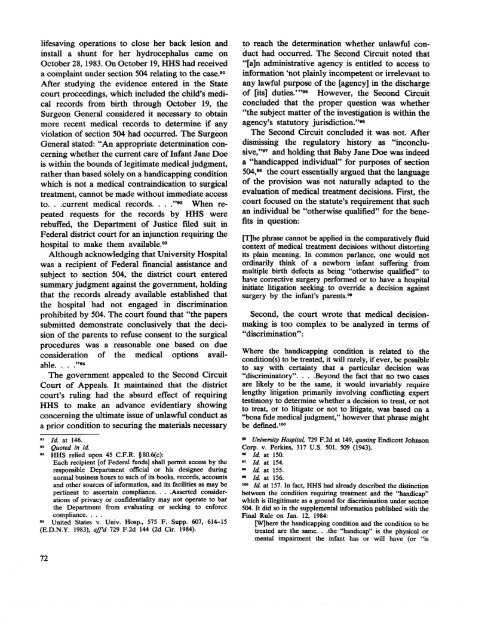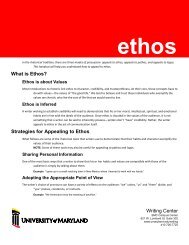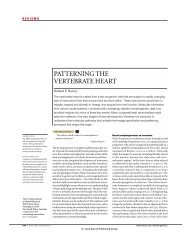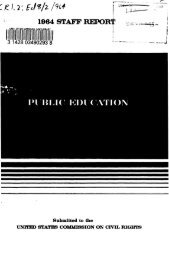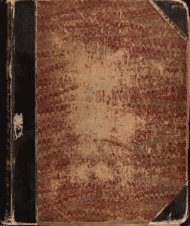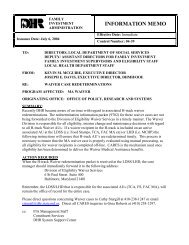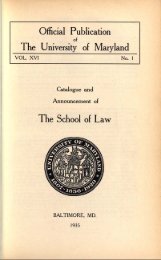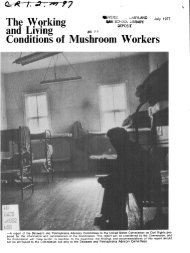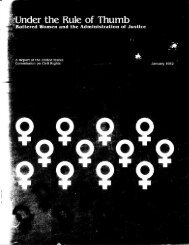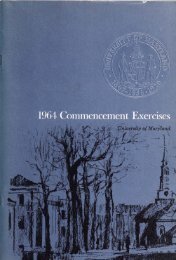lifesaving operations to close her back lesion andinstall a shunt for her hydrocephalus came onOctober 28, 1983. On October 19, HHS had receiveda complaint under section 504 relating to the case. 91After studying the evidence entered in the Statecourt proceedings, which included the child's medicalrecords from birth through October 19, theSurgeon General considered it necessary to obtainmore recent medical records to determine if anyviolation <strong>of</strong> section 504 had occurred. The SurgeonGeneral stated: "An appropriate determination concerningwhether the current care <strong>of</strong> Infant Jane Doeis within the bounds <strong>of</strong> legitimate medical judgment,rather than based solely on a handicapping conditionwhich is not a medical contraindication to surgicaltreatment, cannot be made without immediate accessto. . .current medical records. . . ." 92 When repeatedrequests for the records by HHS wererebuffed, the Department <strong>of</strong> Justice filed suit inFederal district court for an injunction requiring thehospital to make them available. 93Although acknowledging that <strong>University</strong> Hospitalwas a recipient <strong>of</strong> Federal financial assistance andsubject to section 504, the district court enteredsummary judgment against the government, holdingthat the records already available established thatthe hospital had not engaged in discriminationprohibited by 504. The court found that "the paperssubmitted demonstrate conclusively that the decision<strong>of</strong> the parents to refuse consent to the surgicalprocedures was a reasonable one based on dueconsideration <strong>of</strong> the medical options available.. . ." 94The government appealed to the Second CircuitCourt <strong>of</strong> Appeals. It maintained that the districtcourt's ruling had the absurd effect <strong>of</strong> requiringHHS to make an advance evidentiary showingconcerning the ultimate issue <strong>of</strong> unlawful conduct asa prior condition to securing the materials necessary91Id. at 146.92Quoted in id.93HHS relied upon 45 C.F.R. §80.6(c):Each recipient [<strong>of</strong> Federal funds] shall permit access by theresponsible Department <strong>of</strong>ficial or his designee duringnormal business hours to such <strong>of</strong> its books, records, accountsand other sources <strong>of</strong> information, and its facilities as may bepertinent to ascertain compliance. . . .Asserted considerations<strong>of</strong> privacy or confidentiality may not operate to barthe Department from evaluating or seeking to enforcecompliance. . . .94United States v. Univ. Hosp., 575 F. Supp. 607, 614-15(E.D.N.Y. 1983), affd 729 F.2d 144 (2d Cir. 1984).to reach the determination whether unlawful conducthad occurred. The Second Circuit noted that"[a]n administrative agency is entitled to access toinformation 'not plainly incompetent or irrelevant toany lawful purpose <strong>of</strong> the [agency] in the discharge<strong>of</strong> [its] duties.'" 95 However, the Second Circuitconcluded that the proper question was whether"the subject matter <strong>of</strong> the investigation is within theagency's statutory jurisdiction." 96The Second Circuit concluded it was not. Afterdismissing the regulatory history as "inconclusive,"97 and holding that Baby Jane Doe was indeeda "handicapped individual" for purposes <strong>of</strong> section504, 98 the court essentially argued that the language<strong>of</strong> the provision was not naturally adapted to theevaluation <strong>of</strong> medical treatment decisions. First, thecourt focused on the statute's requirement that suchan individual be "otherwise qualified" for the benefitsin question:[T]he phrase cannot be applied in the comparatively fluidcontext <strong>of</strong> medical treatment decisions without distortingits plain meaning. In common parlance, one would notordinarily think <strong>of</strong> a newborn infant suffering frommultiple birth defects as being "otherwise qualified" tohave corrective surgery performed or to have a hospitalinitiate litigation seeking to override a decision againstsurgery by the infant's parents."Second, the court wrote that medical decisionmakingis too complex to be analyzed in terms <strong>of</strong>"discrimination":Where the handicapping condition is related to thecondition(s) to be treated, it will rarely, if ever, be possibleto say with certainty that a particular decision was"discriminatory". . . .Beyond the fact that no two casesare likely to be the same, it would invariably requirelengthy litigation primarily involving conflicting experttestimony to determine whether a decision to treat, or notto treat, or to litigate or not to litigate, was based on a"bona fide medical judgment," however that phrase mightbe defined. 10095<strong>University</strong> Hospital, 729 F.2d at 149, quoting Endicott JohnsonCorp. v. Perkins, 317 U.S. 501, 509 (1943).98Id. at 150.97Id. at 154.98Id at 155.99Id. at 156.100Id. at 157. In fact, HHS had already described the distinctionbetween the condition requiring treatment and the "handicap"which is illegitimate as a ground for discrimination under section504. It did so in the supplemental information published with theFinal Rule on Jan. 12, 1984:[W]here the handicapping condition and the condition to betreated are the same. . .the "handicap" is the physical ormental impairment the infant has or will have (or "is72
Next, the Second Circuit reviewed the legislativehistory <strong>of</strong> section 504 and concluded that "Congressnever contemplated that section 504 would apply totreatment decisions <strong>of</strong> this nature." 101 It quoted withapproval Judge Gesell's dicta in his opinion strikingdown the Interim Final Rule: "[N]o congressionalcommittee or member <strong>of</strong> the House or Senate evereven suggested that section 504 would be used tomonitor medical treatment <strong>of</strong> defective newborninfants or establish standards for preserving a particularquality <strong>of</strong> life. No medical group appeared alertto the intrusion into medical practice which somedoctors apprehend from such an undertaking.. . ." 102Finally, the court took the position that requiringa hospital to go to court or to child protectiveservices agencies to override parental refusals <strong>of</strong>consent to their children's lifesaving treatment"would impose a particularly onerous affirmativeaction burden on the hospital." 103 Although itconceded that the precedent was "not directly onpoint,"-the Second Circuit quoted the 1979 SupremeCourt decision in Southeastern Community College v.Davis 10 * distinguishing between the "evenhandedtreatment <strong>of</strong> qualified handicapped persons" requiredby 504 and "affirmative efforts to overcomethe disabilities caused by handicaps" not required by504. 105 Therefore, the Second Circuit held thatsection 504 did not authorize the type <strong>of</strong> investigationthat had precipitated this lawsuit. 106The government did not ask the Supreme Courtto review <strong>University</strong> Hospital. Baby Jane Doe'sparents changed their minds, directing that theirdaughter be given life-preserving surgery; 107 withthe risk to her life removed, the government nolonger saw a need to pursue the case.Bowen v. American Hospital AssociationFollowing the Second Circuit's decision in <strong>University</strong>Hospital, the American Hospital Associationamended its complaint in an existing suit, and theAmerican Medical Association filed a separate suit,to challenge the four mandatory components <strong>of</strong> theFinal Rule. 108 The plaintiffs in both suits assertedthat the Final Rule was beyond the authority <strong>of</strong>HHS under section 504. The two suits were consolidated.109The district court, regarding the legal issues ashaving been settled by the holdings in <strong>University</strong>Hospital, concluded that the mandatory provisions<strong>of</strong> the Final Rule were "invalid, unlawful and mustbe set aside pursuant to the Administrative ProcedureAct, because [these provisions were] promulgatedwithout statutory authority." 110 The districtcourt issued an extremely broad injunction prohibitingHHS from:regarded as having") after completion <strong>of</strong> the treatment underconsideration. . . .[I]f the surgery would. . .be likely, in theexercise <strong>of</strong> reasonable medical judgment, to bring about itsintended result <strong>of</strong> avoiding. . .fatal consequences, thenfailure to perform the surgery because <strong>of</strong> the anticipatedimpairments in future life <strong>of</strong>fends section 504, as thewithholding <strong>of</strong> surgery is because <strong>of</strong> the handicap and in spite<strong>of</strong> the infant's being qualified to receive the surgery.Final Rule (504), supra note 25, at 1637 (emphasis in the original).101729 F.2d at 157. The legislative history <strong>of</strong> section 504described at the beginning <strong>of</strong> this chapter paints a differentpicture. See supra notes 6-12 and accompanying text.102Id. at 159, quoting Am. Academy <strong>of</strong> Pediatrics v. Heckler, 561F. Supp. at 401.103Id. at 160.104442 U.S. 397 (1979).105<strong>University</strong> Hospital, 729 F.2d at 160, quoting Davis, 442 U.S. at410. HHS took the position that hospitals generally do go to courtor to child protection agencies to override parental refusals <strong>of</strong>consent to lifesaving treatment for nondisabled children (when,for example, parents refuse to consent to blood transfusions fortheir children for religious reasons), so that requiring them to doso on behalf <strong>of</strong> children with disabilities merely mandatesevenhanded treatment, not affirmative action. Final Rule (504),supra note 25, at 1,631.10S<strong>University</strong> Hospital, 729 F.2d at 161. Circuit Judge RalphWinter dissented. He wrote:[In adopting section 504,] Congress was persuaded that ahandicapped condition is analogous to race and that, so far asthe administration <strong>of</strong> federal financial assistance is concerned,discrimination on the basis <strong>of</strong> a handicap should be onstatutory par with discrimination on the basis <strong>of</strong> race.. . .A judgment not to perform certain surgery because aperson is black is not a bonafide medical judgment. So too, adecision not to correct a life threatening digestive problembecause an infant has Down's Syndrome is not a bona fidemedical judgment.Id. at 162.107Kerr, Baby Doe's Success[i\ Legal, Medical Legacy <strong>of</strong> Case,Newsday, Dec. 7, 1987, at 2, col. 2, 23, col. 1.108Additional plaintiffs included the Hospital Association <strong>of</strong>New York State, the American College <strong>of</strong> Obstetricians andGynecologists, the Association <strong>of</strong> American Medical Colleges,the American Academy <strong>of</strong> Family Physicians, and individualphysicians. Bowen v. Am. Hosp. Ass'n, 476 U.S. 610, 613, n.2(1986).109Bowen, 476 U.S. at 620.110Am. Hosp. Ass'n v. Heckler, 585 F. Supp. 541, 542(S.D.N.Y.), affd without opinion 794 F.2d 676 (2d Cir. 1984), affdsub nom. Am. Hosp. Ass'n v. Bowen, 476 U.S. 610 (1986) (citationomitted).73
- Page 1 and 2:
MedicalDiscriminationAgainstChildre
- Page 3 and 4:
idments • Section 504 • Medical
- Page 5:
LETTER OF TRANSMITTALThe PresidentT
- Page 9 and 10:
CONTENTSExecutive Summary 11. Funda
- Page 11:
12. The Performance of the Federal
- Page 14 and 15:
• The role of economic considerat
- Page 16 and 17:
disabilities at the time that the c
- Page 19 and 20:
generated by health care personnel
- Page 21:
ing how they would obtain medical r
- Page 24 and 25:
The Commission sees several advanta
- Page 26 and 27:
acquiescence in the death or elimin
- Page 28 and 29:
Services of the Department of Healt
- Page 30 and 31:
Chapter 1Fundamental Rights: An Int
- Page 32 and 33:
Carlton Johnson was evaluated by a
- Page 34 and 35: "that Mr. and Mrs. Doe, after havin
- Page 36 and 37: American Coalition of Citizens with
- Page 38 and 39: Chapter 2The Physician-Parent Relat
- Page 40 and 41: In all but a few cases, the parents
- Page 42 and 43: the family, and the family went alo
- Page 44 and 45: Chapter 3The Role of Quality of Lif
- Page 47: transition from education to employ
- Page 50 and 51: tion programs can become productive
- Page 52 and 53: unsuccessful efforts of a private a
- Page 54 and 55: [S]ince I have been at Children's M
- Page 56 and 57: Another survey by Siperstein, Wolra
- Page 58 and 59: of life with a child who is disable
- Page 60 and 61: Chapter 4The Role of Economic Consi
- Page 62 and 63: ©TABLE 4.1Pediatricians' Responses
- Page 64 and 65: • The differences in average cost
- Page 66 and 67: FIGURE 4.1Comparative Costs of Inst
- Page 68 and 69: Chapter 5State LawWhat is the law g
- Page 70 and 71: Like all authority. . .parental aut
- Page 72 and 73: This decision, however, was promptl
- Page 74 and 75: No otherwise qualified handicapped
- Page 76 and 77: Bloomington's Infant Doe in April 1
- Page 78 and 79: ONONTABLE 6.1Physician's assessment
- Page 80 and 81: Essentially, HHS interpreted the su
- Page 82 and 83: Final 504 RuleHHS received nearly 1
- Page 86 and 87: any further implementation of the F
- Page 88 and 89: handicapped infants might violate S
- Page 90 and 91: the provision does cover discrimina
- Page 92 and 93: of the infants. The review mechanis
- Page 94 and 95: Under the law, the Department of He
- Page 96 and 97: that "the phrase 'or holds the reas
- Page 98 and 99: allows an infant to be denied nutri
- Page 100 and 101: avoid the explicit standards set fo
- Page 102 and 103: (as opposed to the far) future, the
- Page 104 and 105: It was recognized, therefore, that
- Page 106 and 107: als with the particular disability
- Page 108 and 109: cared for. They are thus different,
- Page 110 and 111: medical advice. Given the magnitude
- Page 112 and 113: tions at all regarding the subject
- Page 114 and 115: strates that there is a grave dange
- Page 116 and 117: Disincentives to Whistle BlowingDen
- Page 118 and 119: Using a cumulative scaling procedur
- Page 120 and 121: Of that 300 we targeted, approximat
- Page 122 and 123: Conclusionphysicians set forth in t
- Page 124 and 125: taking place when a report of suspe
- Page 126 and 127: where the parents say "the child fe
- Page 128 and 129: Nevertheless, the organization oppo
- Page 130 and 131: Chapter 11The Role and Performance
- Page 132 and 133: a member of the American Academy of
- Page 134 and 135:
possibilities that "will be most li
- Page 136 and 137:
clearly indicate that the committee
- Page 138 and 139:
Reviewing the first 30 months of th
- Page 140 and 141:
Webster's defines "suspected" as "t
- Page 142 and 143:
Chapter 12The Performance of the Fe
- Page 144 and 145:
The baby's doctor, E. Laurence Hode
- Page 146 and 147:
to achieve a reasonable life". . .w
- Page 148 and 149:
an unmarried mother receiving welfa
- Page 150 and 151:
can be sure all appropriate actions
- Page 152 and 153:
inquiries to determine whether they
- Page 154 and 155:
Chapter 13The Protection and Advoca
- Page 156 and 157:
authority to conduct retrospective
- Page 158 and 159:
facility that uses such a committee
- Page 160 and 161:
Chapter 14Findings and Recommendati
- Page 162 and 163:
as the coordination and development
- Page 164 and 165:
in the advisory process who is conc
- Page 166 and 167:
A Dissenting View on the Report Med
- Page 168 and 169:
arts) to depend upon knowledge of h
- Page 170 and 171:
Attachments to Statement of William
- Page 172 and 173:
medical facility. Considerations su
- Page 174 and 175:
Fund for the Improvement of Postsec
- Page 176 and 177:
eports such as Kopelman et al. demo
- Page 178 and 179:
Appendix 1EXPOSING OUR CHILDREN, EX
- Page 180 and 181:
abilities or functions, they are de
- Page 182 and 183:
My principal reason for objecting t
- Page 184 and 185:
I derive this hint from the many co
- Page 186 and 187:
moral distinction. A girl is a huma
- Page 188 and 189:
Appendix 2SURVEY OFSTATE BABY DOE P
- Page 190 and 191:
insure the immediate referral of po
- Page 192 and 193:
Hospital Liaisons Designated in Mos
- Page 194 and 195:
BABY DOE COMPARED WITH REGULAR CPS
- Page 196 and 197:
We also asked state CPS offices wha
- Page 198 and 199:
Limited information was available o
- Page 200 and 201:
one-quarter felt that baby doe case
- Page 202 and 203:
Appendix 3INFANT CARE REVIEW COMMIT
- Page 204 and 205:
and guidelines concerning the withh
- Page 206 and 207:
treated to assure the prompt ^repor
- Page 208 and 209:
3. Educating Staff and FamiliesThre
- Page 210 and 211:
One of the 10 ethics committees vis
- Page 212 and 213:
asphyxiation during the birth proce
- Page 214 and 215:
Prospective Review -- Each committe
- Page 216 and 217:
OBSERVATIONSThe inspection found th
- Page 218 and 219:
May 1, 1989Page 2The Commission adv
- Page 220 and 221:
Doe 1 admitted on the record of the
- Page 222 and 223:
tion is the basis for failure to tr
- Page 224:
her (much appreciated) vote for thi


